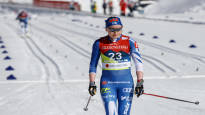The ski association’s financial problems have been a big topic of conversation since the summer. The situation has also been reflected in the athletic side, as, for example, the training days of the A national teams have been shortened.
In addition, during Vuokatti’s joint camp weeks, the athletes have had to pay for accommodation and other expenses themselves.
Raised to a new level in the last couple of years Perttu Hyvärinen admits that the training season has been different compared to previous years. There have been fewer camp periods.
– Of course it affects the training season. However, from the point of view of distance men, the situation looks quite good. Athletes come to the finish line in good shape. If things run in the winter, there shouldn’t be any problem in terms of making a profit, Hyvärinen trusts.
As with many national team skiers, Hyvärinen’s personal training with his own pair of coaches has become even more prominent. The so-called main weight exercises are done in everyday life.
– Everyone has had to do their own things more and camp things personally. It has required more personal partners then.
“There has to be better at this level”
Reached the podium in the traditional sprint last winter Johanna Matintalo belongs to athletes who have participated in all possible national team camps.
He spent his fiance Lauri Vuorinen with several months in Vuokatti. They wanted to take advantage of Vuokatti’s new roller skiing track in their training.
– We had a rented room there for several months. The training company was made up of skiers living in Vuokatti and we got to spar with each other. However, the camps have been in tatters, Matintalo describes.
Matintalo was also at both of the national team’s foreign camps. He says that at the latter camp in Ramsau, he was only alone.
The already quite experienced national team athlete regrets the situation.
– I don’t know if it can be called training as a team if we only have one camp that the team commits to. Teamwork is weak in my opinion.
– From my point of view, I can say that I am the only woman who has visited all the camps and maximized the ski association’s offer. On the other hand, I wish there were more of us athletes. The camp sites have been at a sufficient level, but working as a team at this level needs to be better, Matintalo says.
Camping weakened in six years
Matintalo’s training season was very home-based. He would have preferred to do one more camp abroad.
– When you have wanted to make more use of high altitude training, this training package has not been sufficient in that sense. I still don’t feel that I gave a terrible handicap. If it doesn’t work next winter, I won’t go behind the camp.
Known as a good traditional skier, Matintalo has been with the national team since spring 2017. The skier, who turns 26 in December, has noticed the dwindling of resources over the years.
– We’ve half-jokingly said that this hasn’t gotten better year by year in our time. When I joined the national team in the spring of 2017, the camp season was quite fun as we prepared for the Olympics.
– We also got a really good set for the previous Olympics. The Olympic Committee was very supportive, says Matintalo.
Experts understand
Kerttu Niskanen told Urheilu on Monday at the national skiing team’s media day that he has not been to the A national team’s camps at all this training season.
Sports expert Aino-Kaisa Saarinen understand the perspective of athletes to train outside the national team.
– I understand Kertunk’s solution very well. He has considered that the union is able to offer this kind of thing and it is not enough for him. Even the coaches can’t force the athletes to come to the camp, when there’s really nothing to offer.
Matintalo therefore trained in Ramsau as the only female skier on the national team. Saarinen sees that this can affect the unity of the team.
– It shouldn’t be like this. However, I also understand the athletes who have gone to look for places that are suitable for their situation. Of course, Johanna could have thought about whether she should go to the Ramsau camp if there are no other training buddies there. The athletes have certainly discussed the issue during the season, Saarinen sees.
Urheilu’s second expert Kalle Lassila says that national team training has changed and is changing in a different direction.
– Various international training groups have been formed and the biggest stars are making their own plans and camps. The national team activities during the training season are not so uniform that each country would have its own national teams that would implement their own training season.
Lassila cites, among other things, the joint training of Russians and Italians as examples. There are also American skiers in Norway and Swedish skiers in the United States.
– In the Finnish national team, the economic situation has led to the need to prioritize what is most important. In individual sports, getting results is the most important thing.
– The most important thing for the ski association is to make sure that when the result is made, everything related to it is perfectly fine. Athletes do not stop training, even if there is no national team training. Independence and finding your own solutions can be a big part of the future, Lassila sees.
